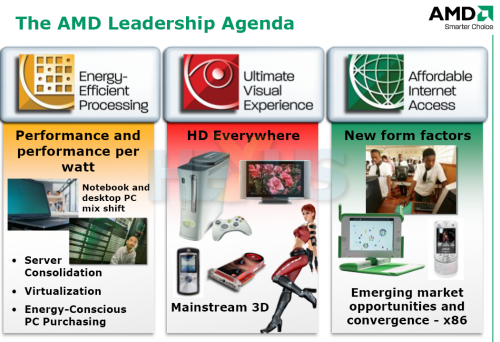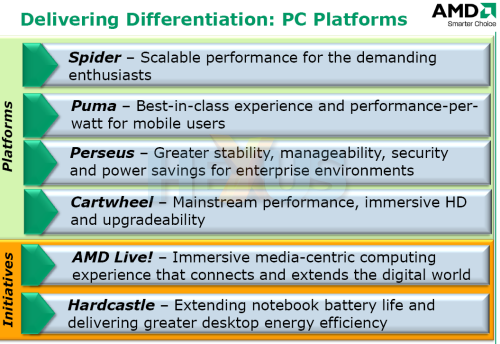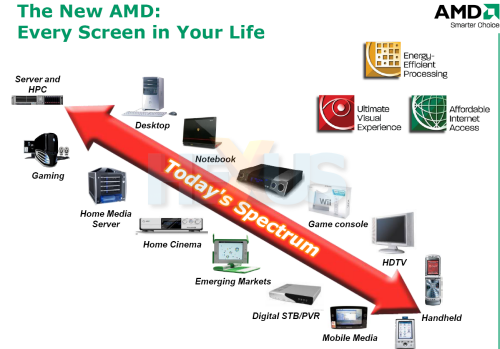Technology changes so quickly that keeping abreast of developments in the semiconductor and GPU industries is a task in itself.
Addressing this issue, Intel has numerous IDFs (Intel Developer Forums) throughout the year, detailing its short- and long-term plans. NVIDIA, too, invites analysts and journalists to a number of editors' days, highlighting technology advances and, to some extent, divulging upcoming product roadmaps. There's a certain security that arises from knowing what billion-dollar companies are committing their extensive research and development budgets to.
But what is AMD doing in 2008, and beyond? That question is especially pertinent considering that the ATI acquisition is now history and any further hiccups to product roadmaps cannot be placed at the door of company integration.
That burning question, relating to how AMD intends to compete on eclectic fronts, has been posed by many and was partially answered at last week's Chief Technology Officers' Summit, held in Amsterdam, Holland.

AMD's how-to-win strategy is based around the three pillars detailed in the above slide. Giuseppe Amato - Technical Director for Sales and Marketing, EMEA - detailed that whilst absolute performance was important, given the exposure now placed upon 'green computing', performance-per-watt was, really, the metric that concerned AMD the most, especially in desktop and mobile environments. AMD's seemingly given up on the top-dog CPU crown and has manifestly directed its strategy towards providing value.
The latest iteration of GPUs have HD in their respective monikers and AMD is pushing ultimate visual experience as a stated aim. Listening to the presentation live, it appears as if AMD's not quite prepared to yield the absolute performance ground (£300+ market) just yet, which is incongruous to its current desktop CPU philosophy. It, however, is still heavily concentrating on volume sales in the volume-shifting £50-£150 space, and that makes implicit sense. Lastly, Amato spoke at length as AMD not only as a money-making business enterprise, but one with a conscience, an enabler of technology to make life better. The 50x15 programme has highlighted as an example of such (almost) altruistic behaviour, as well as openness with its GPGPU programme.

But AMD is a business, and one that's not doing as well as most commentators predicted a few years' ago.
AMD's focussing on providing solutions rather than single-SKU products in 2008, we were told. As such, it's actively branding platforms in each sector, focussing on the fact that the complete solution is more than the sum of the constituent parts (Centrino, anyone?). We already know about the desktop-oriented Spider platform (quad-core processor, 7-series chipset, and 3800-series GPUs) and we've covered the upcoming Puma notebook initiative in detail before (Griffin CPU, Mobility Radeon HD 3000 GPUs, and AMD 780 chipset). AMD detailed that a raft of Puma-based notebooks are on track for release in Q2 2008, but would not be drawn on OEM sign-ups for a platform that will inevitably compete with Intel's well-established Centrino.
Perseus covers AMD's server proposition, represented by its quad-core Barcelona processor, and Cartwheel will take in the Athlon/Phenom CPUs, Radeon 3400-series GPUs, and the IGP-based 780 chipset.
Then there's the interesting area of AMD LIVE!, unvieled at CES this year and based on the LIVE! Explorer user interface which promises to redefine how we interface with content on our PCs.

As a wrap, Amato stressed that AMD product footprint ranges from high-end server SKUs to handheld GPUs (200M-selling, by the way), and that AMD was ideally placed to leverage its unique skillset in 2008.
What we think
AMD's aims for 2008 make sense, focussing on areas where it can at least compete with its main competitors, NVIDIA and Intel.It doesn't have to be the fastest in any particular area as long as it can offer a compelling price-to-performance ratio. Its quad-core processors are reasonably close to Intel's on a price-comparison basis; the Radeon HD 3000-series GPUs offer a better all-round feature-set (DisplayPort, UVD, etc) than NVIDIA's; and its doing well enough in the DTV and handheld markets.
Yes, it doesn't have the big-buck marketing budget of its rivals and is always step behind Intel in manufacturing process and capacity, but the product portfolio and range of products is large enough for it not to disappear overnight, as some doom-mongers are intent on believing.
AMD has a plan to leverage its CPU and GPU technologies in a rather different way, come 2009. Formerly known Fusion, AMD's APUs are soon to arrive. Read on to find out more.













